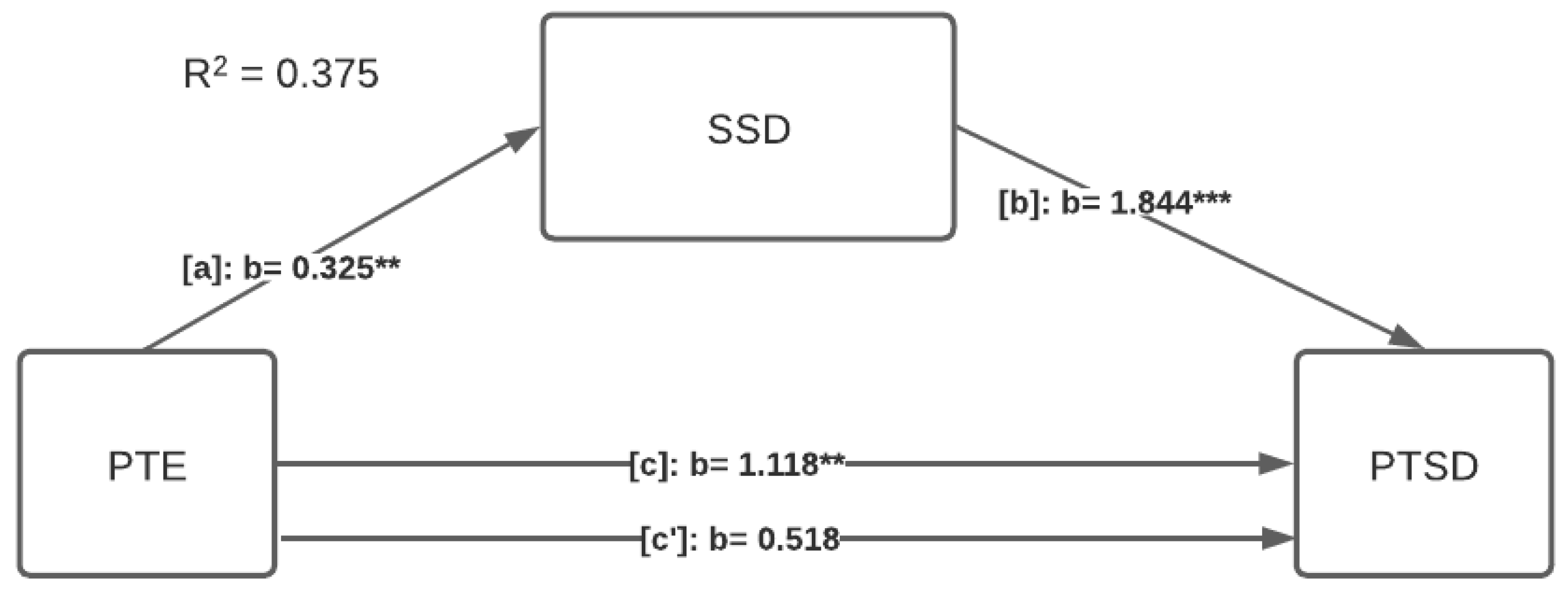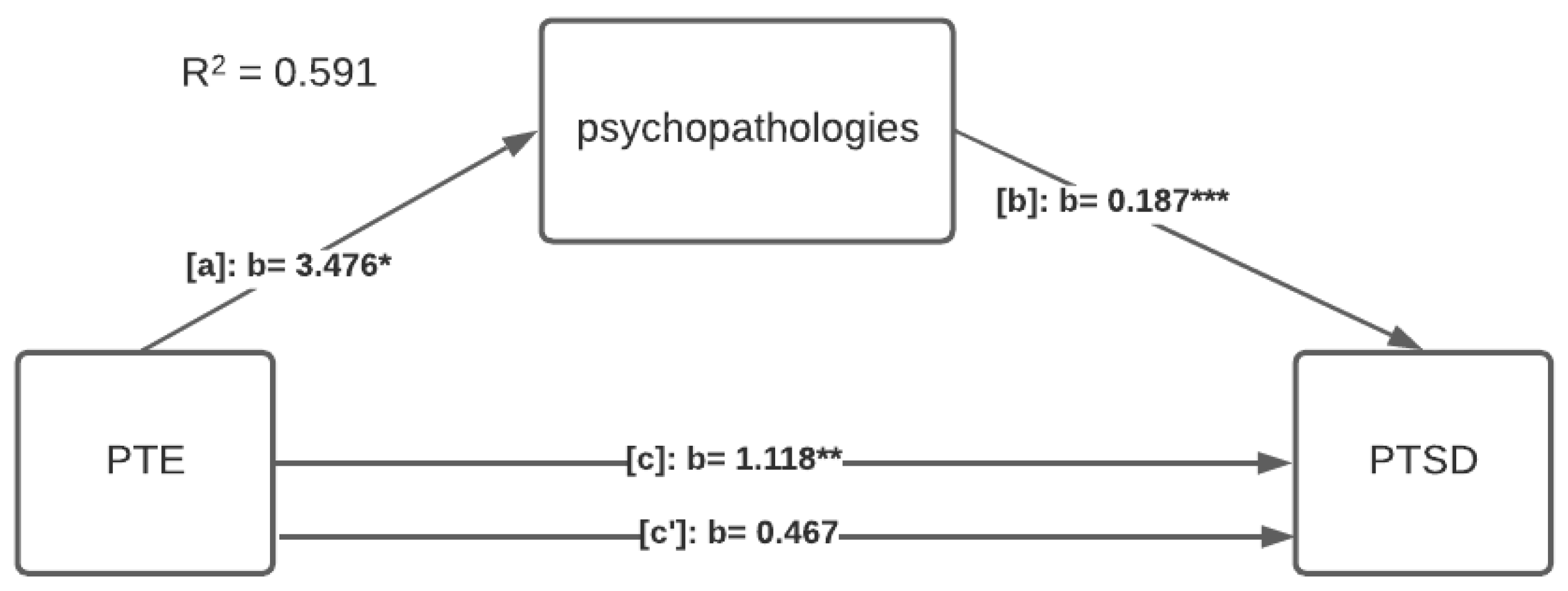Posttraumatic Stress and Somatic Symptoms in Firefighters: A Mediation Analysis of the Impact of Potentially Traumatic Events
Abstract
:1. Introduction
“Although not distinguished in the DSM-5, PTSD can be further differentiated into Primary and Secondary PTSD. The differentiation between Primary and Secondary PTSD is determined depending on the type of exposure to the trauma. Direct exposure as a victim to the traumatic event results in Primary PTSD; while indirect exposure, as an observer of a trauma or close family member/friend of a trauma victim, results in Secondary PTSD. The concept of Secondary PTSD is based on the concept of secondary stress, that is, the stress resulting from indirectly experiencing a traumatizing event experienced by a significant other or the stress resulting from helping or wanting to help a person who has been traumatized”[2] (p. 5).
“The somatization of emotions accounts for a large proportion of family practice visits. Twenty percent of new presentations in primary care and 20–40% of medical outpatient referrals present with high rates of somatization into bodily systems including the respiratory, cardiovascular, gastrointestinal, musculoskeletal, neurological and dermatological systems”[6] (p. 2).
2. Materials and Methods
2.1. Participants
2.2. Measures
2.3. Statistical Analysis
3. Results
4. Discussion
5. Conclusions
Supplementary Materials
Author Contributions
Funding
Institutional Review Board Statement
Informed Consent Statement
Data Availability Statement
Conflicts of Interest
References
- Becker, J.P.; Paixão, R.; Quartilho, M.J. A Relational Model for Stress: A Systematic Review of the Risk and Protective Factors for Stress-Related Diseases in Firefighters. Psych 2020, 2, 74–84. [Google Scholar] [CrossRef]
- Fraess-Phillips, A.; Wagner, S.; Harris, R. Firefighters and traumatic stress: A review. Int. J. Emerg. Serv. 2017, 6, 67–80. [Google Scholar] [CrossRef]
- Brooks, S.K.; Dunn, R.; Amlôt, R.; Greenberg, N.; Rubin, J. Social and occupational factors associated with psychological distress and disorder among disaster responders: A systematic review. BMC Psychol. 2016, 4, 18. [Google Scholar] [CrossRef] [PubMed]
- Milligan-Saville, J.S.; Paterson, H.M.; Harkness, E.L.; Marsh, A.M.; Dobson, M.; Kemp, R.I.; Bryant, R.A.; Harvey, S.B. The Amplification of Common Somatic Symptoms by Posttraumatic Stress Disorder in Firefighters. J. Trauma. Stress 2017, 30, 142–148. [Google Scholar] [CrossRef]
- Becker, J.P.; Paixão, R.; Quartilho, M.J. Psychopathology and Somatic Complaints: A Cross-Sectional Study with Portuguese Adults. Healthcare 2021, 9, 478. [Google Scholar] [CrossRef]
- Cooper, A.; Abbass, A.; Zed, J.; Bedford, L.; Sampalli, T.; Town, J. Implementing a Psychotherapy Service for Medically Unexplained Symptoms in a Primary Care Setting. J. Clin. Med. 2017, 6, 109. [Google Scholar] [CrossRef]
- Simon, G.E.; VonKorff, M.; Piccinelli, M.; Fullerton, C.; Ormel, J. An international study of the relation between somatic symptoms and depression. N. Engl. J. Med. 1999, 341, 1329–1335. [Google Scholar] [CrossRef]
- Carpenter, T.P.; Pennington, M.L.; Seebeck, J.; Gomez, D.R.; Denman, T.C.; Kimbrel, N.A.; Cammarata, C.M.; Leto, F.; Ostiguy, W.J.; Gulliver, S.B. Dispositional self-forgiveness in firefighters predicts less help-seeking stigma and fewer mental health challenges. Stigma Health 2020, 5, 29–37. [Google Scholar] [CrossRef]
- Bartlett, B.A.; Jardin, C.; Martin, C.; Tran, J.K.; Buser, S.; Anestis, M.D.; Vujanovic, A.A. Posttraumatic stress and suicidality among firefighters: The moderating role of distress tolerance. Cogn. Ther. Res. 2018, 42, 483–496. [Google Scholar] [CrossRef]
- Boffa, J.W.; Stanley, I.H.; Hom, M.A.; Norr, A.M.; Joiner, T.E.; Schmidt, N.B. PTSD symptoms and suicidal thoughts and behaviors among firefighters. J. Psychiatr. Res. 2017, 84, 277–283. [Google Scholar] [CrossRef]
- Katsavouni, F.; Bebetsos, E.; Malliou, P.; Beneka, A. The relationship between burnout, PTSD symptoms and injuries in firefighters. Occup. Med. 2016, 66, 32–37. [Google Scholar] [CrossRef] [PubMed]
- Jo, I.; Lee, S.; Sung, G.; Kim, M.; Lee, S.; Park, J.; Lee, K. Relationship between burnout and PTSD symptoms in firefighters: The moderating effects of a sense of calling to firefighting. Int. Arch. Occup. Environ. Health 2018, 91, 117–123. [Google Scholar] [CrossRef] [PubMed]
- Weathers, F.W.; Litz, B.T.; Keane, T.; Palmieri, P.A.; Marx, B.P.; Scnurr, P.P. The PTSD Checklist for DSM-5 (PCL-5). Available online: www.ptsd.va.gov (accessed on 4 March 2022).
- Carvalho, T.; Motta, C.; Pinto-Gouveia, J. Portuguese version of the Posttraumatic Stress Disorder Checklist for DSM-5 (PCL-5): Comparison of latent models and other psychometric analyses. J. Clin. Psychol. 2020, 76, 1267–1282. [Google Scholar] [CrossRef] [PubMed]
- Kroenke, K.; Spitzer, R.; Williams, J. The PHQ-15: Validity of a New Measure for Evaluating the Severity of Somatic Symptoms. Psychosom. Med. 2002, 64, 258–266. [Google Scholar] [CrossRef]
- Gierk, B.; Kohlmann, S.; Toussaint, A.; Wahl, I.; Brünahl, C.; Murray, A.; Löwe, B. Assessing somatic symptom burden: A psychometric comparison of the Patient Health Questionnaire—15 (PHQ-15) and the Somatic Symptom Scale-8 (SSS-8). J. Psychosom. Res. 2015, 78, 352–355. [Google Scholar] [CrossRef]
- Becker, J.P.; Paixão, R.; Quartilho, M.J. Psychometric Properties and Factor Structure of the Portuguese Version of the Patient Health Questionnaire-15 (PHQ-15). Rev. Iberoam. Diagn. Ev. 2023, 69, 43–51. [Google Scholar]
- Derogatis, L.; Melisaratos, N. The Brief Symptom Inventory: An introduction report. Psychol. Med. 1983, 13, 595–605. [Google Scholar] [CrossRef]
- Canavarro, M.C. Inventário de Sintomas Psicopatológicos (BSI): Uma revisão crítica dos estudos realizados em Portugal. In Avaliação Psicológica: Instrumentos Validados Para a População Portuguesa; Simões, M.R., Machado, C., Golçalves, M., Almeida, L.S., Eds.; Quarteto: Coimbra, Portugal, 2007; Volume 3, pp. 305–330. [Google Scholar]
- Lovibond, P.; Lovibond, S.H. The structure of negative emotional states: Comparison of the Depression Anxiety Stress Scales (DASS) with the Beck Depression and Anxiety Inventories. Behav. Res. Ther. 1995, 33, 335–343. [Google Scholar] [CrossRef]
- Vignola, R.; Tucci, A. Adaptation and validation of the depression, anxiety and stress scale (DASS) to Brazilian Portuguese. J. Affect. Disord. 2014, 155, 104–109. [Google Scholar] [CrossRef]
- Hayes, A.F. Introduction to Mediation, Moderation, and Conditional Process Analysis. A Regression-Based Approach, 2nd ed.; Guilford Press: New York, NY, USA, 2017. [Google Scholar]
- Moore, B.A.; Judkins, J.L.; Dyal, M.A.; Schlenk, M.; Meyer, E.; Straud, C.L.; Mysliwiec, V.; Peterson, A.L.; Baker, M.T. Behavioral and Occupational Health in Military Firefighters: An Understudied Population. Behav. Modif. 2022, 46, 453–478. [Google Scholar] [CrossRef]
- Haraldsdóttir, H.A.; Gudmundsdóttir, D.; Romano, E.; Póroardóttir, E.B.; Guomundsdóttir, B.; Elklit, A. Volunteers and professional rescue workers: Traumatization and adaptation after an avalanche disaster. J. Emerg. Manag. 2014, 12, 457–466. [Google Scholar] [CrossRef] [PubMed]
- Stanley, I.H.; Boffa, J.W.; Hom, M.A.; Kimbrel, N.A.; Joiner, T.E. Differences in psychiatric symptoms and barriers to mental health care between volunteer and career firefighters. Psychiatry Res. 2017, 247, 236–242. [Google Scholar] [CrossRef] [PubMed]
- Frost, C.; Toczko, M.; Merrigan, J.J.; Martin, J.R. The effects of sleep on firefighter occupational performance and health: A systematic review and call for action. Sleep Epidemiol. 2021, 1, 100014. [Google Scholar] [CrossRef]
- Becker, J.P.; Paixão, R.; Quartilho, M.J. Dynamic Psychotherapy as a PTSD Treatment for Firefighters: A Case Study. Healthcare 2022, 3, 530. [Google Scholar] [CrossRef]
- Pinto, R.J.; Henriques, S.; Jongenelen, I.; Carvalho, C.; Maia, A. The Strongest Correlates of PTSD for Firefighters: Number, Frequency, or Perceived Threat of Traumatic Events? J. Trauma. Stress 2015, 28, 434–440. [Google Scholar] [CrossRef]
- Qassem, T.; Aly-ElGabry, D.; Alzarouni, A.; Abdel-Aziz, K.; Arnone, D. Psychiatric Co-Morbidities in Post-Traumatic Stress Disorder: Detailed Findings from the Adult Psychiatric Morbidity Survey in the English Population. Psychiatr. Q 2021, 92, 321–330. [Google Scholar] [CrossRef]
- McFarlane Ao, A.C.; Graham, D.K. The ambivalence about accepting the prevalence somatic symptoms in PTSD: Is PTSD a somatic disorder? J. Psychiatr. Res. 2021, 143, 388–394. [Google Scholar] [CrossRef]
- Hinz, A.; Ernst, J.; Glaesmer, H.; Brähler, E.; Rauscher, F.; Petrowski, K.; Kocalevent, R.-D. Frequency of somatic symptoms in the general population: Normative values for the Patient Health Questionnaire-15 (PHQ-15). J. Psychosom. Res. 2017, 96, 27–31. [Google Scholar] [CrossRef]
- Baitha, U.; Ranjan, P.; Deb, K.S.; Bauddh, N.K.; Singh, V.; Kaloiya, G.; Kumar, A.; Sahu, A. Association of somatic symptom severity with sociodemographic parameters in patients with medically unexplained physical symptoms: A cross-sectional study from a tertiary care center in India. Cureus 2020, 12, e9250. [Google Scholar] [CrossRef]


Disclaimer/Publisher’s Note: The statements, opinions and data contained in all publications are solely those of the individual author(s) and contributor(s) and not of MDPI and/or the editor(s). MDPI and/or the editor(s) disclaim responsibility for any injury to people or property resulting from any ideas, methods, instructions or products referred to in the content. |
© 2023 by the authors. Licensee MDPI, Basel, Switzerland. This article is an open access article distributed under the terms and conditions of the Creative Commons Attribution (CC BY) license (https://creativecommons.org/licenses/by/4.0/).
Share and Cite
Becker, J.P.; Paixão, R.; Correia-Santos, P.; Quartilho, M.J. Posttraumatic Stress and Somatic Symptoms in Firefighters: A Mediation Analysis of the Impact of Potentially Traumatic Events. Societies 2023, 13, 206. https://doi.org/10.3390/soc13090206
Becker JP, Paixão R, Correia-Santos P, Quartilho MJ. Posttraumatic Stress and Somatic Symptoms in Firefighters: A Mediation Analysis of the Impact of Potentially Traumatic Events. Societies. 2023; 13(9):206. https://doi.org/10.3390/soc13090206
Chicago/Turabian StyleBecker, Joana Proença, Rui Paixão, Patrícia Correia-Santos, and Manuel João Quartilho. 2023. "Posttraumatic Stress and Somatic Symptoms in Firefighters: A Mediation Analysis of the Impact of Potentially Traumatic Events" Societies 13, no. 9: 206. https://doi.org/10.3390/soc13090206
APA StyleBecker, J. P., Paixão, R., Correia-Santos, P., & Quartilho, M. J. (2023). Posttraumatic Stress and Somatic Symptoms in Firefighters: A Mediation Analysis of the Impact of Potentially Traumatic Events. Societies, 13(9), 206. https://doi.org/10.3390/soc13090206










